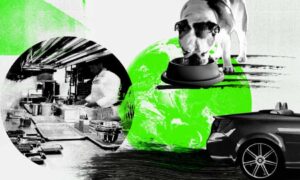
Restaurants, pets and foreign holidays are among the reasons why the UK’s most well-off people rack up carbon footprints far greater than those on low incomes, according to data shared with the Guardian.
The biggest carbon divide is in aviation, with the richest 10% in the UK – the 6.7 million people paid more than £59,000 a year – causing more than six times more climate-heating emissions from flights than the poorest 10%. Spending on electrical items, homeware and furniture also contributes to the outsize impact of the wealthy, who splash out four times more on these goods.
There is also a generational divide, the data shows, with baby boomers having the largest and growing carbon footprints, significantly higher than generation X and millennials. The biggest geographical divide is between London and the rest of the UK, with those in the capital having substantially lower footprints due to much better public transport.
Recognising inequalities in carbon emissions is essential to making climate action fair and effective, experts say. The rich have the most emissions to cut and have the means to do so, while the poor may rebel against policies that make already stretched lives harder.
“There’s a massive range in people’s footprints,” said Dr Anne Owen, a carbon footprint expert at the University of Leeds. “For aviation, it’s massive. The richest in society are flying many, many times more than the poorest. Also, restaurants, hotels – luxury consumption – and other services, which could be anything from theatre to financial services.”
Owen said the government’s levies on home energy bills to raise money for net zero policies showed the problem of ignoring the great carbon divide: “You could not pick a worse product to place a carbon tax or levy on.”
Owen’s research shows that the lowest-income households spend 10% of their income on heating and powering their homes, while the highest spend less than 1.5%. So the increase in prices hits the poor disproportionately, despite their much lower carbon footprints.
“Instead, the levies could be put on air travel – then you would end up getting the richest in society paying far more,” she said. “Or you could just put it on income tax, which is already designed to work with people’s levels of income.” The latter option would cut energy bills for 65% of households.
“Switching to electric cars is also something that the wealthier end of society can do,” she said. “It doesn’t change their lifestyle much but it will reduce their carbon footprint by huge amounts. So, obviously, the government pushing back the date [for the end of sales of new combustion-engine cars] is ridiculous.”
Owen’s findings are based on analysis of surveys conducted by the Office for National Statistics. They show that the richest 10% have heavy travel footprints. As well as many more flights, they take far more trains and their car use causes three times more emissions than that of the poorest 10%.
